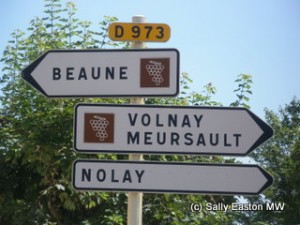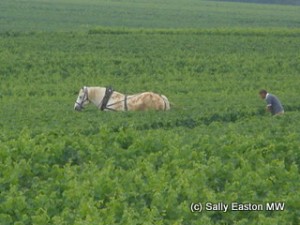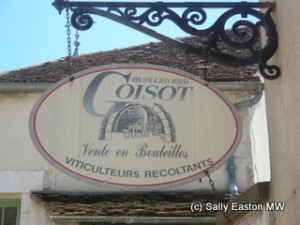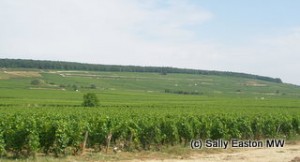Sustainable viticulture in Burgundy
 A much shorter version of this article first appeared in Drinks Business, July 2011.
A much shorter version of this article first appeared in Drinks Business, July 2011.
With pioneering icons such as Domaine Leflaive and Domaine Pierre Morey who live and breathe biodynamics, Burgundy has long been at the forefront of green viticulture. But in a perfect marketing storm where almost everyone says they’re doing sustainable viticulture, even if they don’t really, how do you separate marketing myth from substantive sustainability?
Outside of conventional production, and the biodynamic niche, there are two main ways of producing wine in Burgundy – sustainable development, and organic. Both can be certified, meaning at least minimum standards have been achieved.
Certified organic is one thing that feels reasonably well understood, and such vineyards in Burgundy have grown rapidly. In 2001, it is estimated that about 1% of Burgundy vineyards were certified organic. Jean-Hugues Goisot of certified organic and biodynamic Domaine Goisot, said “In the last year, there’s been an increase of 45-55% of the surface of vineyards certified. By 2011, 9-10% will be certified.”
It’s not just that more producers are certifying organic. There appears to be a sea change in the mindset of producers. Anne Parent of Domaine Parent believes “the next 10 years will be a hundred times quicker than last 10 years” even though her own evolution has been steady, “Before me, my brother stopped herbicides, just ploughed. When I took over 12 years ago I said we need to go further. We didn’t know exactly how to go, so we did some soil and leaf analysis. We observed each plot, and did what it needs, no more, no less. In 10 years it was a long process. In 2005/6 we started to work some plots organically. We did more tests, and in 2009, we decided to go organic.”
The downside she said “is it costs more. You use less quantity especially with an efficient pneumatic sprayer, but have to do more treatments because the efficacy of the product is short.”
But, she added, over and above the organic regulations, she is working this way to “protect the soil and the terroir, and for our health. It’s not a fashion, it’s a long term philosophy.”
At Maison Champy, for winemaking technical director Dimitri Bazas, the proof of their non-certified biodynamic techniques is in his team’s pudding, as it were. He said “the success is that the team finish the products in their own gardens. In the field they are doing an application because they have observed. It is no longer a dogmatic spraying regime.”

Return to traditional practices
Certainly producers appear to be thinking more about what they are doing, and not spraying according to an industrial regime, by the calendar. Part of this is due to a system of agriculture raisonée (AR) which, for viticulture, comes in the form of a 90-point specification, issued by FARRE, the national association of agriculture raisonée.
Some of the points are obligatory, others not. In addition, producers can be third-party certified in AR, or not, as they choose. And herein lies a serious communication issue. Denis Fetzmann, director of Domaine Louis Latour said “agriculture raisonée’ is a light control and not generally very successful in France. Everyone says ‘we are in sustainable development’ but [when it is not certified] no one controls it.”
It’s difficult to have much confidence in a non-certified system which is open to misuse. And, Fetzmann added the standards “are checked every five years. We have had three audits since 2004, and the standards have not changed” so there is, so far, no tightening of tolerances over time, which should be an essential part of any certification, in order to increase levels of sustainability over time.
And while agriculture raisonée allows the use of synthetic chemicals, whereas organic and biodynamic use natural applications, including sulphur and copper, the benefits are that the system considers more than just the vineyard plot: it sits on the tripod of economic viability, human health and protection of the environment.
“It’s not just for the winery, but for the whole estate, and for the safety of the workers” said Jérôme Sordet, of agriculture raisonnée-certified Domaine Coste-Caumartin, adding “before I was certified, on average I did 12 sprays, spraying when it was easiest, about every 10 days. Now it’s about 8 sprays, taking into account the weather, and I use about 15% less. I have been taught how to read the leaves, so I see if treatment is needed or not.”
But Sordet spends 15-20% more time in the vineyards on his 12 hectare property. And he and his team now meet twice a day. “It’s an optimisation of work” he said, “it doesn’t cost any more. My labour cost has not come down, I still have the same four people, but they are doing more diverse things.”
Essentially AR measures are common sense, though the approach requires a pre-existing or learned environmentally-protective mentality. Some people were already doing them, and now it is part of a programme. And sometimes a lot of small changes can add up. The system also includes traceability protocols.
Taking some aspects a little further is the private organisation Terra Vitis, which is a member of FARRE. Its members must adhere both to the AR specification, and to the third-party certified Terra Vitis specification, which was created in 2009. Their viticultural advisor, Jean-Henri Soumireu-Lartigue said “we integrated new commitments dealing with biodiversity, energy use and water quality.”
Given that synthetic chemicals, and systemic rather than contact products, are permitted under AR, he also said “the association selects synthetic chemicals based on their toxicity. The more toxic chemicals are forbidden” adding “we generally use about 30% less chemicals. But we also use less toxic chemicals.”
 Chemical build up in the soil or not, a return to terroir and typicity is a driving force for some to adopt a less synthetic approach to their winemaking.
Chemical build up in the soil or not, a return to terroir and typicity is a driving force for some to adopt a less synthetic approach to their winemaking.
Jean-Hugues Goisot, organic since 2000 and biodynamic since 2005, said “between 1990 and 2000, I had an impression that we lost, little by little, the typicity of our wine. We were more chardonnay and sauvignon blanc rather than Cote d’Auxerre and St Bris – chardonnay from our domaine and from Australia and Chile were getting closer and closer.”
In 1996, they tested a four hectare parcel under organic. Goisot said “in blind tastings, we knew each time which was organic, it was more typical of the region. We preferred the organic wine every time, therefore we took the decision to make everything organic.“
It’s also such a return to terroir that has driven Maison Champy, the oldest negociant in Burgundy, towards organic. Their technical director, Dimitri Bazas, said “It’s a return to the experiential, it’s a re-questioning. It’s good to be awake. It’s about terroir wines – wines from Champy must be Pommard before they are Champy.”
He said “you cannot do this in conventional farming. When you use synthetic fertilisers, the same fertilisers in Pommard and Volnay, the roots stay 10 to 15cm in the soil. If you don’t have microbiological life, if you don’t have roots in the subsoil there is no terroir.” And he added “the sustainable thing, terroir, is here for long time, but we are here for short time.” Pragmatically, he added, the idea is to produce better grapes.
Maison Champy was certified organic from the 2010 vintage. Joseph Drouhin has also recently completed the paperwork to convert, even though an organic way of working has been in place for over 20 years. Fourth generation estates manager Philippe Drouhin said “in 1988, fresh out of viticultural school, I was convinced the synthetic way of managing vineyards was risky and might be a dead end. In 1988, yellow and red mites were a big problem. The beginning of the discovery for me was Typhlodromus pyri, a small mite that eats the other mites. The new chemicals [at the time] had to avoid damaging the pyri; and no-one now uses chemicals against yellow and red mite.”
Of their recent organic certification Drouhin said “we wanted the organic certificate, even though it’s never used commercially. Now it becomes a selling point for some estates, and there is a tendency for some estates to let people think they were organic when they weren’t. I felt in 2006 it was necessary to ask for certification. It changed nothing but the paperwork and expense. It was just to be able to prove we are actually doing it.“
Such a quiet approach is not unique in Burgundy. Maison William Fèvre doesn’t shout that they are certified AR, plus half their 50 hectares of vineyards are certified organic. Didier Seguier, their winemaker said “it’s difficult to manage organic viticulture quickly. We want to be all organic, maybe it will take another five years.” But he added “the other 25 hectares have only three chemical treatments.” Fèvre have not decided if they will put organic on the label. Seguier said their aim was “to use less and less chemical product.”
Without the certificate though, accurate and comprehensible communication remains a challenge, as Drouhin found. Ironically, Christophe Chauvel, the head viticulturist at Albert Bichot, who practise aspects of AR, but are not certified, said the way we work “is not a marketing thing, it’s a philosophy. It’s better for me to practise it, but not talk about it,” which seems to be the position Drouhin were at a few years ago.

Hill of Corton
A significantly louder line in the sand is being drawn in Aloxe Corton, where Domaine (not Maison) Louis Latour, certified ISO 14001, and certified agriculture raisonée, launched the ‘Paysage de Corton’ initiative in July 2010. For Domaine director Denis Fetzmann, “the argument is not synthetic versus organic” For him, the “new challenge is the protection of territory – the hill of Corton”, encouraging all producers to think of the whole appellation and its wider environment.
The Paysage de Corton project aims to cover the 100 domaines on the hill of Corton in three villages – Pernand-Vergelesses, Aloxe-Corton and Ladoix-Serrigny – covering a thousand hectares of vineyard and non-vineyard land.
Fetzmann said, with organic, “you are chief on your little plot. Everything is your choice. But we have questions which are not for one plot, for example, erosion – it needs controlling, there are some steep plots. We decide among several domaines to slow the water flow, or to build some stone walls.”
Also, he said “biodiversity is not just about your plot. We have made traps everywhere, working for 10 years to understand if the way of viticulture in Burgundy is compatible with life in the soil, air, insects etc.”
Fetzmann’s mantra is “terroir and territory. This is the new way of viticulture” he said. The 1,000 hectares of the hill comprises 550ha of vineyards, the rest is roads, forest, buildings etc, but the initiative aims to get the whole working holistically. He said they are working “to manage a territory intelligently, and not alone. For example we want to create more hedgerow corridors from high to low points to help life circulate” on the hill of Corton, to aid biodiversity, and they have two research students working to this, and other, ends, one financed by Louis Latour, the other by the BIVB.
He added, “I’ve already worked for one year on the project … though the work is for the next 30 years”, so he’s not expecting too many quick wins. But at the first meeting in July 2010, 40 domaines, including Drouhin and DRC have already signed up to the initiative, as have all the organic growers in Corton. This shows there is a collective will to change attitudes and practices for the environmental better.
As with Burgundy’s biodynamic icons, the Corton Hill project could be a beacon of biodiversity for Burgundy.
My research trip to Burgundy in July 2010 was sponsored by the ‘Discover the Origin‘ campaign.



